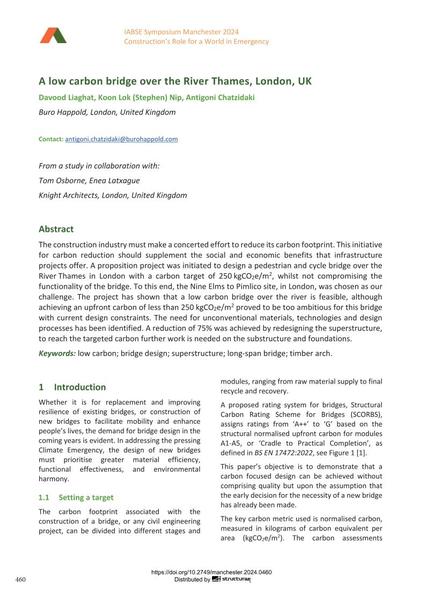A low carbon bridge over the River Thames, London, UK

|
|
|||||||||||
Détails bibliographiques
| Auteur(s): |
Davood Liaghat
(Buro Happold, London, United Kingdom)
Koon Lok (Stephen) Nip (Buro Happold, London, United Kingdom) Antigoni Chatzidaki (Buro Happold, London, United Kingdom) Tom Osborne (Knight Architects, London, United Kingdom) Enea Latxague (Knight Architects, London, United Kingdom) |
||||
|---|---|---|---|---|---|
| Médium: | papier de conférence | ||||
| Langue(s): | anglais | ||||
| Conférence: | IABSE Symposium: Construction’s Role for a World in Emergency, Manchester, United Kingdom, 10-14 April 2024 | ||||
| Publié dans: | IABSE Symposium Manchester 2024 | ||||
|
|||||
| Page(s): | 460-468 | ||||
| Nombre total de pages (du PDF): | 9 | ||||
| DOI: | 10.2749/manchester.2024.0460 | ||||
| Abstrait: |
The construction industry must make a concerted effort to reduce its carbon footprint. This initiative for carbon reduction should supplement the social and economic benefits that infrastructure projects offer. A proposition project was initiated to design a pedestrian and cycle bridge over the River Thames in London with a carbon target of 250 kgCO2e/m2, whilst not compromising the functionality of the bridge. To this end, the Nine Elms to Pimlico site, in London, was chosen as our challenge. The project has shown that a low carbon bridge over the river is feasible, although achieving an upfront carbon of less than 250 kgCO2e/m2 proved to be too ambitious for this bridge with current design constraints. The need for unconventional materials, technologies and design processes has been identified. A reduction of 75% was achieved by redesigning the superstructure, to reach the targeted carbon further work is needed on the substructure and foundations. |
||||
| Mots-clé: |
superstructure
|
||||
